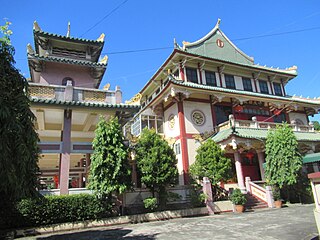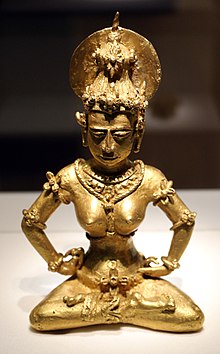
The history of Southeast Asia covers the people of Southeast Asia from prehistory to the present in two distinct sub-regions: Mainland Southeast Asia and Maritime Southeast Asia. Mainland Southeast Asia comprises Cambodia, Laos, Myanmar, Peninsular Malaysia, Thailand and Vietnam whereas Maritime Southeast Asia comprises Brunei, Cocos (Keeling) Islands, Christmas Island, East Malaysia, East Timor, Indonesia, Philippines and Singapore.

Hinduism in Southeast Asia had a profound impact on the region's cultural development and its history. As the Indic scripts were introduced from the Indian subcontinent, people of Southeast Asia entered the historical period by producing their earliest inscriptions around the 1st to 5th century CE. Today, Hindus in Southeast Asia are mainly Overseas Indians and Balinese. There are also Javanese and Balamon Cham minority in Cambodia and south central Vietnam who also practice Hinduism.

Srivijaya, also spelled Sri Vijaya, was a Buddhist thalassocratic empire based on the island of Sumatra that influenced much of Southeast Asia. Srivijaya was an important centre for the expansion of Buddhism from the 7th to 11th century AD. Srivijaya was the first polity to dominate much of western Maritime Southeast Asia. Due to its location, Srivijaya developed complex technology utilizing maritime resources. In addition, its economy became progressively reliant on the booming trade in the region, thus transforming it into a prestige goods-based economy.

The Shailendra dynasty was the name of a notable Indianised dynasty that emerged in 8th-century Java, whose reign signified a cultural renaissance in the region. The Shailendras were active promoters of Mahayana Buddhism and covered the Kedu Plain of Central Java with Buddhist monuments, one of which is the colossal stupa of Borobudur, now a UNESCO World Heritage Site.

Greater India, also known as the Indian cultural sphere, or the Indic world, is an area composed of several countries and regions in South Asia, East Asia and Southeast Asia that were historically influenced by Indian culture, which itself formed from the various distinct indigenous cultures of South Asia. It is an umbrella term encompassing the Indian subcontinent and surrounding countries, which are culturally linked through a diverse cultural cline. These countries have been transformed to varying degrees by the acceptance and introduction of cultural and institutional elements from each other. The term Greater India as a reference to the Indian cultural sphere was popularised by a network of Bengali scholars in the 1920s, but became obsolete in the 1970s.

Recent archaeological and other evidence suggests Hinduism has had some cultural, economic, political and religious influence in the Philippines. Among these is the 9th century Laguna Copperplate Inscription found in 1989, deciphered in 1992 to be Kawi script with Sanskrit words; the golden Agusan statue discovered in another part of Philippines in 1917 has also been linked to Hinduism.

Buddhism is a minor religion in the Philippines. It is practiced by 2% of the population in 2016, primarily by Filipinos of Chinese descent. The number of Buddhists in the country has been dwindling due to the lack or no significant presence of Buddhist missionary works where the teachings of the Buddha are translated and taught to the native regional languages.
Indonesian Esoteric Buddhism or Esoteric Buddhism in Maritime Southeast Asia refers to the traditions of Esoteric Buddhism found in Maritime Southeast Asia which emerged in the 7th century along the maritime trade routes and port cities of the Indonesian islands of Java and Sumatra as well as in Malaysia. These esoteric forms were spread by pilgrims and Tantric masters who received royal patronage from royal dynasties like the Sailendras and the Srivijaya. This tradition was also linked by the maritime trade routes with Indian Vajrayana, Tantric Buddhism in Sinhala, Cham and Khmer lands and in China and Japan, to the extent that it is hard to separate them completely and it is better to speak of a complex of "Esoteric Buddhism of Mediaeval Maritime Asia." Many key Indian port cities saw the growth of Esoteric Buddhism, a tradition which coexisted alongside Shaivism.

In early Philippine history, the Tagalog settlement at Tondo, sometimes referred to as the Kingdom of Tondo, was a major trade hub located on the northern part of the Pasig River delta, on Luzon island. Together with Maynila, the polity (bayan) that was also situated on the southern part of the Pasig River delta, had established a shared monopoly on the trade of Chinese goods throughout the rest of the Philippine archipelago, making it an established force in trade throughout Southeast Asia and East Asia.

In Philippine history, the Tagalog bayan of Maynila was one of the most cosmopolitan of the early historic settlements on the Philippine archipelago. Fortified with a wooden palisade which was appropriate for the predominant battle tactics of its time, it lay on the southern part of the Pasig River delta, where the district of Intramuros in Manila currently stands, and across the river from the separately-led Tondo polity.

The recorded history of the Philippines between 900 and 1565 begins with the creation of the Laguna Copperplate Inscription in 900 and ends with the beginning of Spanish colonization in 1565. The inscription records its date of creation in 822 Saka. The discovery of this document marks the end of the prehistory of the Philippines at 900 AD. During this historical time period, the Philippine archipelago was home to numerous kingdoms and sultanates and was a part of the Indosphere and Sinosphere.
Religions in pre-colonial Philippines included a variety of faiths, of which the dominant faiths were polytheist indigenous religions practiced by the more than one hundred distinct ethnic groups in the archipelago. Buddhism, Hinduism, and Islam were also present in some parts of the islands. Many of the traditions and belief systems from pre-colonial Filipino religions continue to be practiced today through the Indigenous Philippine folk religions, Folk Catholicism, Folk Hinduism, among others.

Southeast Asia was in the Indian sphere of cultural influence from 290 BCE to the 15th century CE, when Hindu-Buddhist influences were incorporated into local political systems. Kingdoms in the southeast coast of the Indian subcontinent had established trade, cultural and political relations with Southeast Asian kingdoms in Burma, Bhutan, Thailand, the Sunda Islands, Malay Peninsula, Philippines, Cambodia, Laos, and Champa. This led to the Indianisation and Sanskritisation of Southeast Asia within the Indosphere, Southeast Asian polities were the Indianised Hindu-Buddhist Mandala.
Kedatuan were historical semi-independent city-states or principalities throughout ancient Maritime Southeast Asia in the present-day Philippines, Indonesia, and Malaysia. In a modern Indonesian/Malay sense, they could be described as kingdoms or polities. The earliest written record mentioning the term kadatuan was the 7th-century Srivijayan Telaga Batu and Kota Kapur inscription from Sumatra, Indonesia.

In 1025 CE, the Chola Emperor Rajendra I launched naval raids on Srivijaya in maritime Southeast Asia. Rajendra's overseas expedition against Srivijaya was a unique event in India's history and its otherwise peaceful relations with the states of Southeast Asia. Several places in present-day Indonesia and Malay Peninsula were invaded by Rajendra I of the Chola dynasty. The Chola invasion furthered the expansion of Tamil merchant associations such as the Manigramam, Ayyavole and Ainnurruvar into Southeast Asia. The Cholan invasion led to the fall of the Sailendra Dynasty of Srivijaya and the Chola invasion also coincides with return voyage of the great Bengali Buddhist scholar Atiśa from Sumatra to India and Tibet in 1025 CE.

Pannai, Panai or Pane was a Buddhist kingdom located on the east coast of Northern Sumatra that existed between the 11th and 14th centuries. The kingdom was located on the Barumun River and Panai River valleys, in today's Labuhan Batu and South Tapanuli regencies. Because surviving inscriptions and historical records of this period are scarce, the kingdom is among the least known political entities in Indonesian history. Historians suggest that Pannai was probably a principality or a vassal allied under the Srivijayan mandala and later to Dharmasraya kingdom.
In the Philippine languages, a system of titles and honorifics was used extensively during the pre-colonial era, mostly by the Tagalogs and Visayans. These were borrowed from the Malay system of honorifics obtained from the Moro peoples of Mindanao, which in turn was based on the Indianized Sanskrit honorifics system and the Chinese's used in areas like Ma-i (Mindoro) and Pangasinan. The titles of historical figures such as Rajah Sulayman, Lakandula and Dayang Kalangitan evidence Indian influence. Malay titles are still used by the royal houses of Sulu, Maguindanao, Maranao and Iranun on the southern Philippine island of Mindanao. However, these are retained on a traditional basis as the 1987 Constitution explicitly reaffirms the abolition of royal and noble titles in the republic.

The indigenous religious beliefs of the Tagalog people were well documented by Spanish missionaries, mostly in the form of epistolary accounts (relaciones) and entries in various dictionaries compiled by missionary friars.

The Maritime Silk Road or Maritime Silk Route is the maritime section of the historic Silk Road that connected Southeast Asia, East Asia, the Indian subcontinent, the Arabian Peninsula, eastern Africa, and Europe. It began by the 2nd century BCE and flourished until the 15th century CE. The Maritime Silk Road was primarily established and operated by Austronesian sailors in Southeast Asia who sailed large long-distance ocean-going sewn-plank and lashed‑lug trade ships. The route was also utilized by the dhows of the Persian and Arab traders in the Arabian Sea and beyond, and the Tamil merchants in South Asia. China also started building their own trade ships (chuán) and followed the routes in the later period, from the 10th to the 15th centuries CE.














